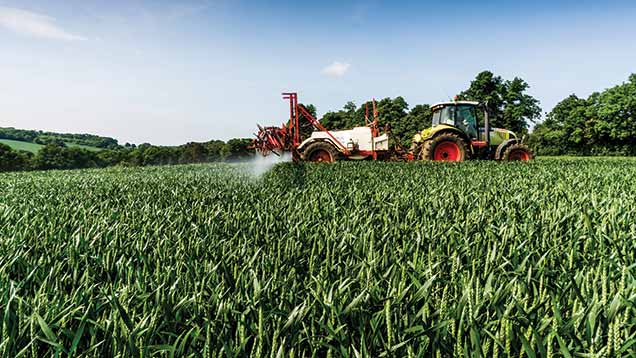Angled sprayer nozzles give best wheat ear disease control

Angling sprayer nozzles when applying the T3 fungicide on wheat crops offers improved control of fusarium infection, according to new research.
T3 fungicides are typically applied using flat fan nozzles angled 90deg to the crop, but angling nozzles may give better coverage of the ear.
See also: Risk assessment vital to beat fusarium in wheat
Angled nozzles have proved successful when hitting difficult targets like small blackgrass plants when applying herbicides.
“We wanted to test whether you get better coverage by angling the nozzles and if there are any benefits on disease control,” says Phil Jennings of Fera.
“Ears are pointing upwards and you need get as much coverage on them for good control.”
This was put to the test last year in inoculation trials with the T3 applied with nozzles either at 90deg or 30-40deg facing forward.
“We also looked at timing [90deg only], comparing growth stage 63 with the older recommendation of GS59 to confirm that current advice gave the best results.”
Products tested included Proline (prothioconazole) applied at 0.55 litres/ha, Prosaro (prothioconazole + tebuconazole) at 0.8 litres/ha, tebuconazole at 0.75 litres/ha and Brutus (epoxiconazole + metconazole) at 1.5 litres/ha.
Crops were then inoculated with both F graminearum and F culmorum at GS65 (9 June) and assessed for signs of disease at GS75.
Thousand grain weight (TGW), specific weight and mycotoxin levels were also monitored in the grain.
“The first thing to note is that there were very high levels of disease in the untreated plots, with disease affecting an average of 40% of ear area. This is way above what you will see in the field. We were testing treatments under very harsh conditions,” he says.
Timing
Looking at timing, applying the T3 at GS63 gave better control over GS59, with a 56% reduction in severity (ear area affected [JT2] ) with prothioconazole, 49% reduction for prothioconazole + tebuconazole and 40% with epoxiconazole + metconazole.
Incidence also fell, the highest reduction being 30% (% ears affected) for prothioconazole + tebuconazole.
“This confirmed that mid flowering is the optimum time for T3 fungicides,” says Dr Jennings.
But he warns that there is a short window for the T3 spray and missing it by a few days can lead to a marked drop in efficacy.
“However, if you are a little late, you do still get some kick-back activity.”
Nozzles
Angling nozzles resulted in better control. “Looking at disease severity, there was a consistent response across all products [PJ3].”
For example, tebuconazole saw a 38% reduction from 24% to 15% severity and prothioconazole fell by 36% from 11 to 7% severity.
Angling nozzles also reduced incidence, with Prosaro seeing a 24% reduction in the number of infected ears, 29% for prothioconazole and 13% for tebconazole. However, there was no improvement in either severity or incidence for epoxiconazole + metconazole.
Similar results were seen in a separate trial conducted at Harper Adams University College, says Dr Jennings, but with nozzles angled backwards.
“It seems not to matter which way the nozzles are facing, but more the fact they are angled. I believe it is offering better coverage of the ear.”
Importantly for farmers, the improved disease control with angled nozzles led to improvements in thousand grain weight, specific weight and mycotoxins levels.
In conclusion, his advice for this season is to apply T3s at GS63 and to use angled nozzles. “Also stick with robust rates of active, especially if it is wet at flowering.”
Fusarium ear blight snapshot
Early indications suggest there is potential for 2015 to be a significant fusarium ear blight year if conditions remain favourable.
Last season, 70% of crops had fusarium symptoms, says Phil Jennings. “This suggests there was high inoculum pressure due to favourable spring conditions.”
The majority of the symptoms were caused by microdochium, with 60% of crops infected. “Last year was the third highest in the last 10 years in terms of the number of crops infected by microdochium.”
But when it came to harvest, Fusarium culmorum and graminearum levels were low, suggesting weather at flowering was not favourable for infection.
With microdochium, only 10% of ears within a crop showed infection and on these, typically only one or two spikelets were infected, so much less than in 2012, where 35% of ears within crops were infected and typically 10-15 spikelets infected.
So while the pressure from last year (inoculum carryover) is not particularly high, the winter was fairly favourable and not overly cold. “This suits microdochium and to some extent, fusarium too.
“And now we have seen warm spring conditions. Being relatively dry and mild is good for both microdochium and fusarium.”
Therefore, he believes there is potential for inoculum to build up in crops in the coming weeks.
“This now depends on conditions in May. Fusarium graminearum produces perithecia (fruiting bodies) in crop debris and they need moisture in May to mature and produce spores. The longer-term forecast is wetter, therefore, more conducive to produce spores.”


